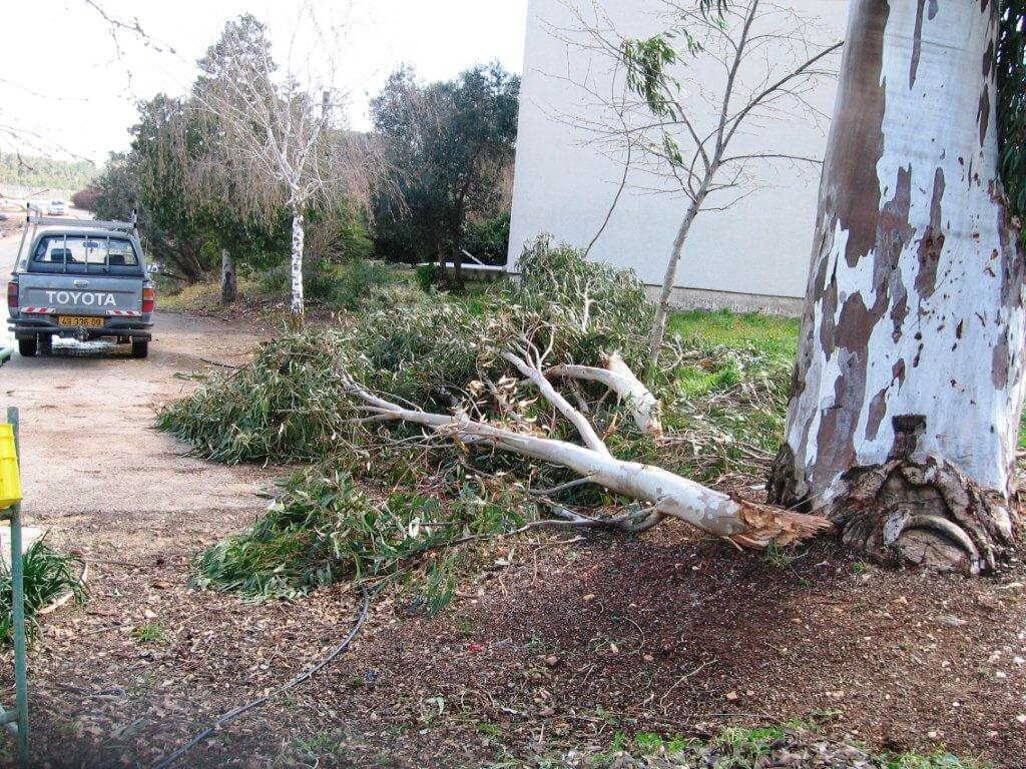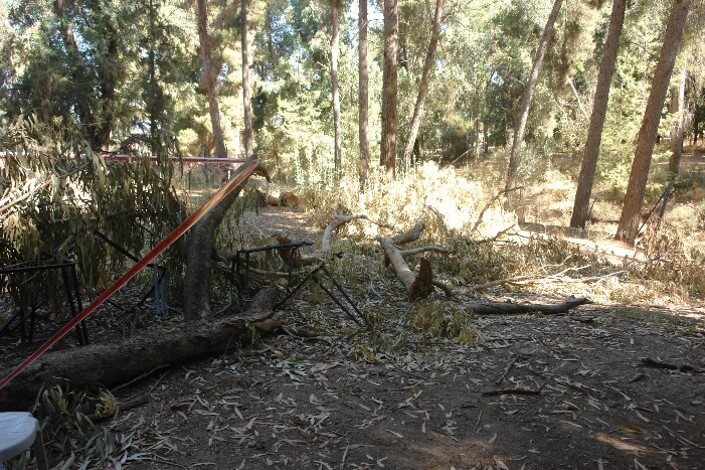Researchers warn of an unknown phenomenon that could be life-threatening: falling branches in the summer
By Omer Yerushalmi, Angle - a news agency for science and the environment

One of the best-known anecdotes in the history of science is about the time when an apple falling from a tree caused Newton to discover the existence of gravity. Luckily for him and us, it was only a single apple that fell on his head, and not a whole branch. Many do not know this, but branches from healthy trees may fall to the ground during the summer, without any prior warning. In the article A new Israeli, recently published in KKL-Junk's "Yer" magazine, examines the phenomenon, which is relatively small in scope, but which may lead to psychological harm. The authors of the article are trying to raise awareness of the phenomenon among the experts and the public - before the next accident occurs.
Usually, when you think of accidents that occur due to the collapse of tree branches, images of a severe storm, raging winds and hail or snow that burden the trees come to mind. This perception is mostly correct, branches fall mainly in winter, but not only. Branches from trees also fall in the summer - which is no less dangerous. While in the winter storms people tend to stay in their houses, when a branch falls in the summer, the chances of someone resting in the shade of the tree are significantly higher. In three incidents, which took place in the mountainous Jordan in 2001, in the Jordan Park in 2010 and in the "Action Park" in the Lachish region in 2019, casualties were caused due to falling branches in the summer. In addition, quite a few cases of injuries that can be attributed to this phenomenon are recognized in Israel.
Until recently, the belief that falling branches is a danger only in winter was not only the property of the public, and the perception among professionals in Israel, whether it is the Ministry of Agriculture or private agronomists, was that falling branches in summer is not a problem that should be checked when reviewing the risks posed by a particular tree.
"I have been aware of this phenomenon for about a year and a half to two years," says Abigail Heller, head of the field of botanical gardens and settlement agriculture at the Ministry of Agriculture and the author of the article. "I was taught that branches fall in the summer only if the trees are near water sources, but I have seen in several cases that this is not necessarily the case. I started asking and finding out about the matter, and as soon as I got to the right academic literature, it cleared my mind."
conflicting explanations
Heller and her team, which included private agronomists and agronomists from the Department of Agriculture at the Hebrew University, followed the academic knowledge on the topic of summer branch drop, and discovered that the phenomenon has been known around the world since the end of the 19th century, that it occurs in branches that are larger than 10 centimeters in diameter, and that in Israel it appears mainly in various eucalyptus and ficus species And in Oren Jerusalem.
However, according to the article, the possible explanations for the phenomenon are many, and even contradict each other - and not every explanation given in Europe that is relevant to the local tree species is also suitable for Israel and the tree species that are characteristic of it.
The two main approaches in the world to explain the phenomenon are related to the concept of the industry's water potential: the ability of water to move from region to region. Heller illustrates the idea of water potential through laundry: "Wet laundry has a high water potential," she says. "The water potential in hot and dry air, on the other hand, is low. The water moves from a place where the water potential is high to a place where it is low, and thus the laundry dries." For this reason, if the air outside is humid, the laundry does not dry - because the water inside has nowhere to go.
According to one explanation, a similar phenomenon occurs in branches during the summer. If the air outside is hot and dry, the water in the transport pipes, the pipes that are used to transport water from the roots to the branches, evaporates into the air. "When this happens, the pipes shrink, and as a result, cracks form along the branches, which can lead to their breaking and falling."
A parallel explanation for the phenomenon speaks of the fact that a positive water potential causes the branches to break. According to this explanation, when it is hot and humid there is nowhere for the water in the transport pipes to "escape" into the air. In such a situation, the tree closes its leaves, the microscopic openings in the leaves through which photosynthesis and water evaporation take place. "That way, the water stays inside the branch," explains Heller. "When the tree continues to carry water from the roots upwards, an excess of water is created in the branches, the weight of the branch increases and it breaks."
Anticipate the fall in advance
Whether the tree branches fall due to high or low water potential, it is important to understand that this is a danger to the public. Branches usually do not show significant defects before they break, so it is difficult to identify in advance which branch will fall and when - but there are some rules of thumb regarding the types of branches prone to falling.
The new article includes guidelines for preventing risks from falling branches, which are addressed to the community of agronomists and professionals who are responsible for managing risks in the field and pruning trees, but are also relevant to the public in general. "It is important to bring to mind the need to look for defects and problem branches when surveying trees," says Heller. These defects include, but are not limited to, those more familiar to reviewers, such as decay. "Nowadays, when I teach surveyors how to perform a risk assessment in trees, I also guide them to pay attention to long, horizontal and arching branches, which are the ones that are more likely to fall in the summer. When you find such branches, you should check if it is possible to shorten them and reduce their weight."

The researchers also include in the article guidelines that are more relevant to municipal authorities and national parks, and suggest limiting activity in sites that receive crowds where many trees are planted on hot and dry days, just as entry to these areas is limited on stormy days. Alternatively, the researchers suggest that in the first place trees that are prone to summer branch fall should not be planted in such areas, and that the trees that have been planted there in the past should undergo a risk assessment review (especially in sites where there are a large number of old and aging trees of the types and species that are prone to this phenomenon).
prevent unnecessary death
However, the guidelines offered by the authors of the article are not binding. At the national level, the Ministry of Agriculture does not have a set of tree surveyors, and there is no law that regulates the treatment of trees and that requires their inspection every few years. If reviews are conducted, this is done at the initiative of the local municipality or by private entities.
The Ministry of Agriculture published in 2019 General document for tree risk management, compiled by Heller as part of her job and intended to help the various surveyors carry out their work faithfully. And really, at the municipal level, some municipalities have their own procedures on the subject, which rely on the guidelines of the Ministry of Agriculture. However, not every municipality has a municipal procedure document, and the large amount of trees makes it difficult to check each and every one of them (in Tel Aviv-Jaffa alone, for example, About 150 thousand trees are planted).
According to Heller, attention should be paid to the phenomenon, even though the number of people it kills is small compared to other risk factors. "Throughout the twenty years that I have been in my position, there have been about 10 injuries to the soul for various reasons related to trees," she says. "It may be 'only' one case every two years, but we must also prevent this one unnecessary death."
More of the topic in Hayadan:
